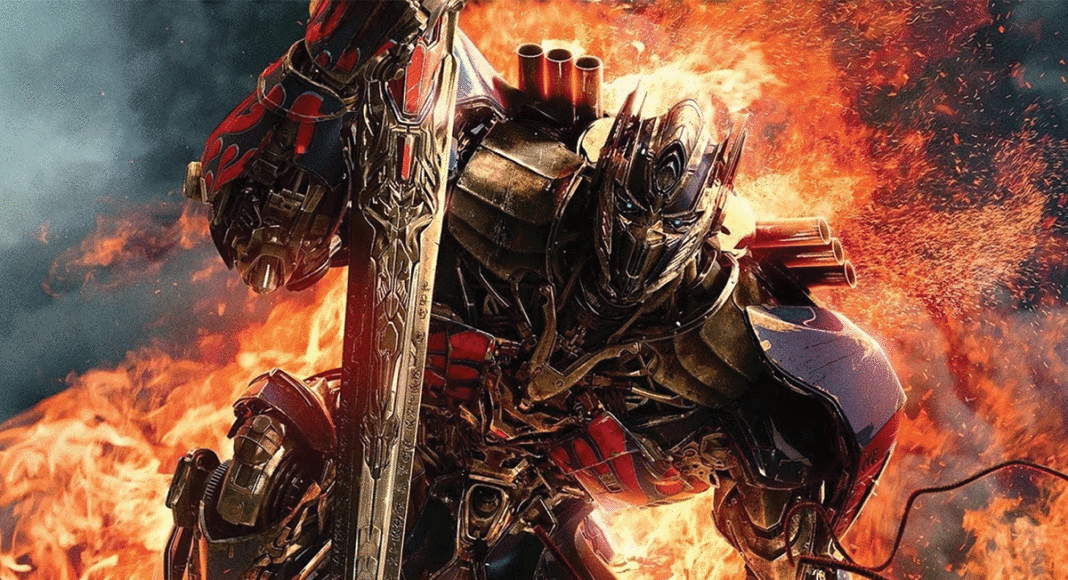Like a wealthy scrap merchant seeking a coat of arms, director Michael Bay hired Anthony Hopkins’ integrity to fluff up the class of Transformers: The Last Knight. As “Sir Edmund Burton,” an earl with historical connections to the medieval roots of this Transformers business, Hopkins keeps a level voice intoning lines like “without sacrifice, there can be no victory … without leaders, chaos reigns.”
The speediest way down the path to madness is to try to synopsize a Michael Bay movie. It begins in King Arthur’s day with a drunken Merlin (Stanley Tucci) muttering dialogue that could be improved by any Renaissance faire busker. The magus unleashes a three-headed mega-Ghidrah to save Arthur’s skin.
The Arthurian scenes look more lavish and exciting than the recent King Arthur movie by Guy Ritchie, but then it’s off to our near future. It’s a dark time—we know this because we’re told it’s a dark time. The Transformer robots are in hiding and being besieged by soldiers, and Optimus Prime has floated off to find his home world.
Above the clashes, we almost hear something topical about immigrants (“One day, we’ll wake up and they’ll be in charge,” says a character of the ’bots). In the colossus-battered slums of Chicago, the plucky little girl Izabelle (Isabela Moner)—who will give the movie’s climactic fist pump and shout of “Yes!”—looks like she’s going to be the movie’s heroine. But she’s off to a junkyard in the Dakotas where Mark Wahlberg is waiting—his Cade Yeager is protecting an odd lot of bots, including a burly soldier voiced by John Goodman.
Ever restless, Bay heads for Oxford, where the hottie history professor Vivian Wembley (Laura Haddock) is insulting the memory of King Arthur because of long-standing father issues. Sad things happen in this movie, but maybe the saddest is when Yeagar accuses this skinny, Olivia Wilde-like Oxford don of wearing a stripper dress, and she replies, “I could take it off if it would make you more comfortable.”
Locations, locations: Stonehenge, Havana, Namibia. At one point John Turturro is on the phone claiming that Dublin’s Book of Kells is printed on “goat scrotum” (parchment). Why go after the Book of Kells? And what was this movie’s script printed on?
I’ve heard the vulgar-auteur arguments about how Bay’s ability to blow stuff up mitigates the really terrible dialogue that occurs again and again in his work. And there are certain sequences that justify the gigantism of it all, such as a robot in pieces pulling himself together in mid-air while simultaneously clobbering a group of soldiers. It may be that movies that have quite good demolition sequences don’t require defending—the first Avengers movie, for instance, where the Manhattan skyscrapers seemed to be fulfilling their architectural function by exploding into fountains of glass, or the low angle car chase in Rome in Spectre, particularly exciting in IMAX. Since the critical loathing for the Transformers saga is so high, you’ll hear that we’re missing something—an angle on the maligned genius of Bay.
There is craft here. It’s a pity the movie is bewilderingly bad, with Bay’s reliably smelly sexual politics perfuming the joint. Giant robots are impressive when they punch their mammoth heads out of a 3D IMAX screen; in closeup, these mega-goliaths look like the work of Boris Artzybasheff, who did for gears and bolts what the artist Arcimboldo did for zucchinis. But watching Bay, you never know where you are, you never know who’s shouting, you never know why every entity in the universe has to bump its chest or bitchslap something’s face.
TRANSFORMERS With Mark Wahlberg, Laura Haddock, Stanley Tucci and Anthony Hopkins. Written by Art Markum, Matt Holloway and Ken Nolan. Directed by Michael Bay. PG-13; 150 minutes.












